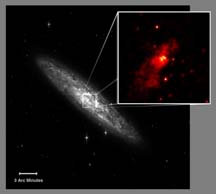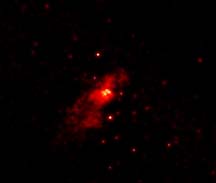Imagine the Universe News - 5 June 2001
New Type of Black Hole May Turn Starburst Galaxies Inside Out
| 05 June 2001 |
Starburst galaxies -- those distant gems set aglow in a colorful lifecycle of star birth, death and renewal -- may be the stepping stone to a far brighter phenomenon: a quasar-type galaxy with a supermassive black hole at its core.
NASA's Chandra X-ray Observatory is finding that starburst galaxies have a proportionally higher number of what appears to be intermediate-size black holes, a new type of object announced last year. Chandra images also suggest that these black holes may be sinking to the center of one particular starburst galaxy, where they would merge with each other to create an engine that could illuminate a core millions of times brighter than the entire Milky Way galaxy.

The stunning spiral galaxy NGC 253 and
the false-colored Chandra observation taken near its central region.
NGC 253, with its furious star production, is a Seyfert galaxy. |
Dr. Kimberly Weaver of NASA's Goddard Space Flight Center in Greenbelt, Md., presented the implications of new Chandra observations of starburst galaxies during the 198th meeting of the American Astronomical Society held in Pasadena, California during the week of June 4, 2001.
"With Chandra, nearly every day we are finding more of these point-like sources that appear to be hundreds or thousands of times more massive than the 'ordinary' type of stellar black hole formed when massive stars collapse," says Weaver. "The big questions are: What are these objects, and what role do they play in galaxy evolution?"
Scientists call the newly found objects "ultraluminous X-ray sources"; they also have been referred to over the past year as mid-mass and intermediate-size black holes. These objects are found outside of the core of many types of galaxies. In starburst galaxies, Weaver says, these sources may take on a particular significance.
Starburst galaxies are known for their brightness caused by a high concentration of young, massive stars and supernova explosions. The bulk of a starburst galaxy's luminosity is from outside of the core region.
Other types of bright galaxies -- such as quasars, blazars and Seyferts -- emit most of their light from the core region, a phenomenon called an Active Galactic Nucleus, or AGN. The engine of the AGN is thought to be a supermassive black hole, which could contain the mass of billions of suns confined to a region about the size of our solar system.
Weaver is finding that starbursts may evolve into AGN. Gas expelled from numerous star explosions may collide and collapse into intermediate-size black holes. These smaller black holes may sink to the center of the galaxy to form a single supermassive black hole. The supermassive black hole, in turn, would grow larger and release fantastic amounts of energy as it pulls in more and more gas from the galaxy core. This would then turn the light source of the galaxy "inside out," making the core bright instead of the disk.

The X-ray observation showing the ultraluminous point sources. |
With Chandra, Weaver studied the galaxy NGC 253, a relatively nearby, classical starburst galaxy about 10 million light-years from Earth. This galaxy had no prior evidence of an X-ray-emitting AGN. This galaxy has at least 10 ultraluminous point sources, and three of them are located within about 3,000 light years from the galaxy core. That's close, and it may imply that the ultraluminous objects -- often found slightly farther out -- are gravitating towards the center of the galaxy.
In the core and farther back in the disk of NGC 253, Weaver has also found a type of X-ray light from hot iron atoms that may be from dense molecular clouds lit up by a budding AGN.
"Could it be that this starburst galaxy is transforming itself into a quasar-like galaxy as we watch," asks Weaver. "We have known for several years that starburst activity can be associated with AGN activity. In NGC 253, Chandra may have found a causal connection."
Weaver's collaborators on this observation were Drs. David Strickland and Timothy Heckman of Johns Hopkins University. The team observed NGC 253 for 3.5 hours with Chandra's Advanced CCD Imaging Spectrometer (ACIS).

